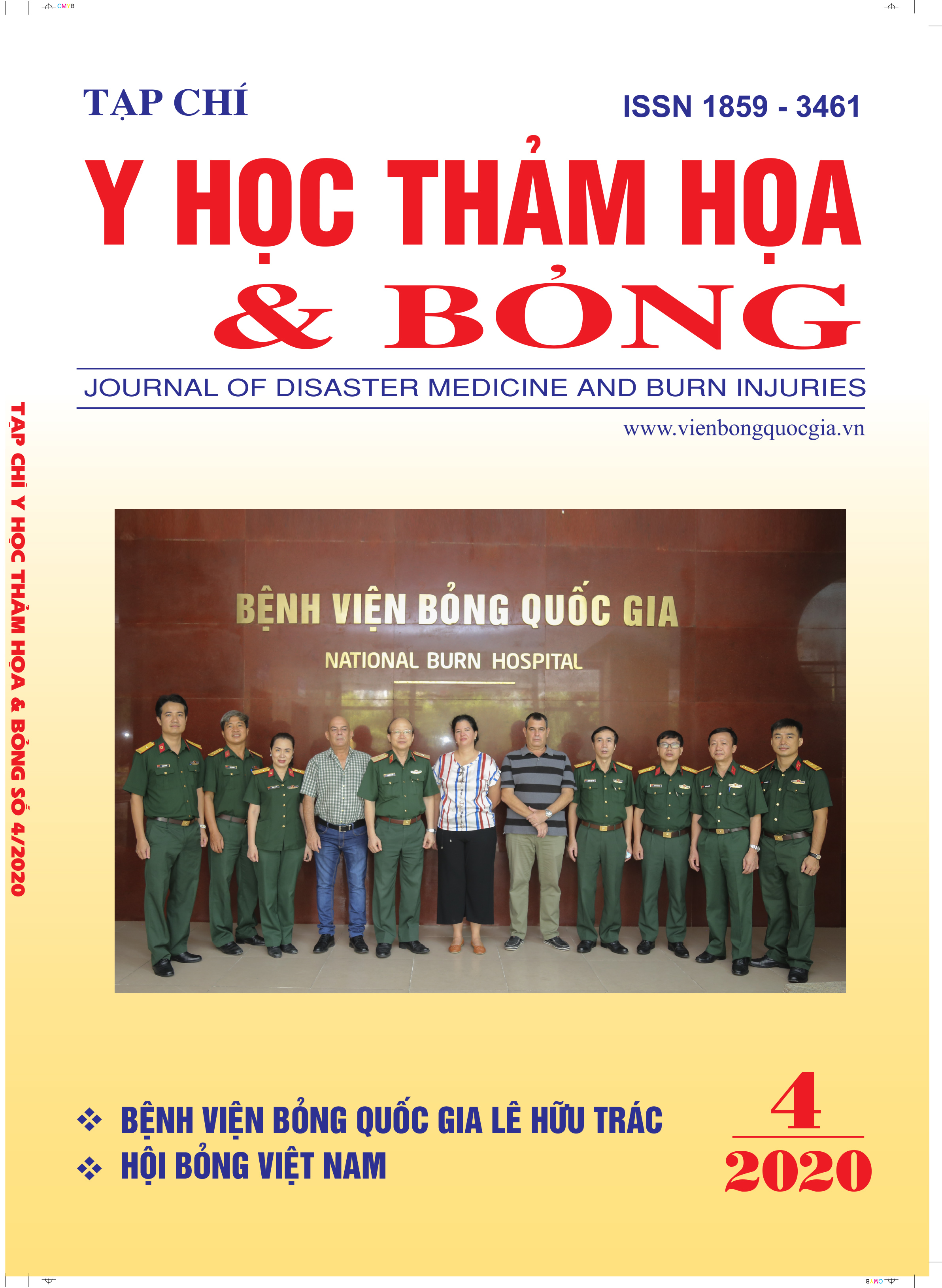Research the difference between EGF and VEGF concentrations in patients with chronic wounds treated with Platelet-rich plasma (PRP).
Main Article Content
Abstract
In chronic wounds, there is a disorder of the regeneration and epithelization process. One of the reasons is the depletion of GF. Platelet-rich plasma for the treatment of chronic wounds is an effective, highly safe, minimally invasive therapy. Objectives of the study are:
1. To evaluate the difference between EGF and VEGF concentrations in PRP before and after activation.
2. To evaluate the difference between EGF, VEGF concentrations in the area of chronic wounds treated with PRP.
The study was conducted on 24 patients with chronic wounds, aged from 18 years old and above, treated (by injection of PRP at wound site) at the National Burns Hospital from 11/2018 to 2/2020. Quantification of EGF and VEGF based on the Elisa principle, using the standard substances EGF/VEGF and antibodies specific to EGF/VEGF.
The results showed that the concentrations of EGF/VEGF in PRP increased after activation; concentrations of EGF and VEGF in wound tissue also increased after 1 week of treatment.
Conclusion: The PRP therapy at a wound site has the effect of stimulating wound healing through increasing EGF and VEGF in chronic wounds.
Article Details
References
2. Menke N.B., Ward K.R., Witten T.M., Bonchev D.G., Diegelmann R.F. “Impaired wound healing”. Clin Dermatol. 2007, 25:19-25
3. Dowsett C. “Breaking the cycle of hard-to-heal wounds: balancing cost and care”. Wounds International 2015, Vol 6 Issue 2.
4. Marta Otero-Viñas and Vincent Falanga. “Mesenchymal Stem Cells in Chronic Wounds: The Spectrum from Basic to Advanced Therapy”. Adv Wound Care (New Rochelle) 2016, Apr 1; 5(4): 149-163.
5. Banfi G. “Platelet-rich plasma”. Journal of biological regulators and homeostatic agents 2012;26, 1.
6. Amable P.R., Carias, R.B., Teixeira, M.V., da Cruz Pacheco, I., Correa do Amaral R.J., Granjeiro J.M. and Borojevic R. “Platelet-rich plasma preparation for regenerative medicine: optimization and quantification of cytokines and growth factors”. Stem cell research & therapy, 2013, 4 (3): 67
7. Elena Conde-Montero, Pablo de la Cueva Dobao, José María Martínez González. “Platelet-rich plasma for the treatment of chronic wounds: evidence to date”. Chronic Wound Care Management and Research. 2017, Vol 2017:4 107-120
8. Krister Järbrink, Gao Ni, Henrik Sönnergren, Artur Schmidtchen, Caroline Pang, Ram Bajpai and Josip Ca. “Prevalence and incidence of chronic wounds and related complications: a protocol for a systematic review”. Syst Rev. 2016; 5(1): 152
9. National Pressure Ulcer Advisory Panel (NPUAP); Pressure Injury Stages, http://www.npuap.org, 2016.
10. Vladimir N. Obolenskiy, Darya A. Ermolova, Leonid A. Laberko. “Efficacy of platelet-rich plasma for the treatment of chronic wounds”. The EWMA Journal, volume 14, No 1, April 2014, p. 37-40.
11. Mehrannia M., Vaezi M., Yousefshahi F., Rouhipour N. “Platelet-rich plasma for treatment of nonhealing diabetic foot ulcers: a case report”. CJD (Canadian journal of diabetes), February 2014, Volume 38, Issue 1, Pages 5 - 8.
12. Javier Ramos-Torrecillas, Elvira De Luna-Bertos, Olga García-Martínez. “Clinical Utility of Growth Factors and Platelet-Rich Plasma in Tissue Regeneration: A Review”. Wounds. 2014; 26(7):207-213
13. Diegelmann R.F. and Evans M.C. “Wound Healing: An Overview of acute, fibrotic and delayed healing”. Frontiers in Bioscience 9, 283-289
14. George Han and Roger Ceilley.“Chronic Wound Healing: A Review of Current Management and Treatments”. Adv Ther. 2017; 34(3): 599–610.
15. Sabine Werner and Richard; Regulation of Wound Healing by Growth Factors and Cytokines; Gros Physiol Rev 83: 835–870, 2003;
16. Stephan Barrientos; Olivera Stojadinovic, Michael S. Golinko, Harold Brem, Marjana Tomic-Canic (2008), Growth factors and cytokines in wound healing; Wound Repair and RegenerationWound, (2008), 16, 585–601
17. Hart J.Inflammation. 1: Its role in the healing of acute wounds. J Wound Care. 2002 Jun; 11(6):205-9.
18. Zhang Y, Wang T, Dong J (2016); Growth factor therapy in patients with partial-thickness burns: a systematic review and meta-analysis. Wound J. 2016 Jun; 13(3): 354-66.
19. Sho Yamakawa & Kenji Hayashida. Advances in surgical applications of growth factors for wound healing; Burns & Trauma, Volume 7, Article number: 10 (2019).
20. Park JW, Hwang SR, Yoon IS. Advanced growth factor delivery systems in wound management and skin regeneration. Molecules. 2017; 22:E1259.
21. Nanney LB. Epidermal and dermal effects of epidermal growth factor during wound repair. J Invest Dermatol. 1990; 94:624–9.
22. J.Hardwicke, D.Schmaljohann, D.Boyce, D.Thomas; Epidermal growth factor therapy and wound healing — past, present and future perspectives; The SurgeonVolume 6, Issue 3, June 2008, Pages 172-177
23. Brown GL, Curtsinger LJ, White M, Mitchell RO, Pietsch J, Nordquist R, et al. Acceleration of tensile strength of incisions treated with EGF and TGF-beta. Ann Surg. 1988; 208:788–94.
24. Kelly E. Johnson and Traci A. Wilgus (2014); Vascular Endothelial Growth Factor and Angiogenesis in the Regulation of Cutaneous Wound Repair; Adv Wound Care. 2014 Oct 1; 3(10): 647–661.
25. Thittamaranahalli Muguregowda Honnegowda, Pramod Kumar, Echalasara Govindarama Padmanabha Udupa, Sudesh Kumar, Udaya Kumar, Pragna Rao (2015); Role of angiogenesis and angiogenic factors in acute and chronic wound healing; Plast Aesthet Res 2015; 2:.243-249
26. Tatiana N. Demidova-Rice, Lindsey Wolf, Jeffry Deckenback, Michael R. Hamblin, Ira M. Herman (2012). “Human Platelet-Rich Plasma- and Extracellular Matrix-Derived Peptides Promote Impaired Cutaneous Wound Healing In vivo”. PLOS. https://doi.org/10.1371/journal.pone.0032146


